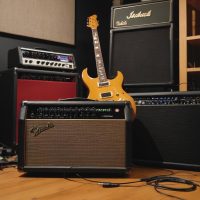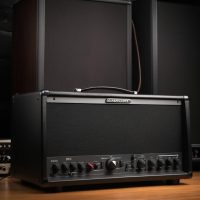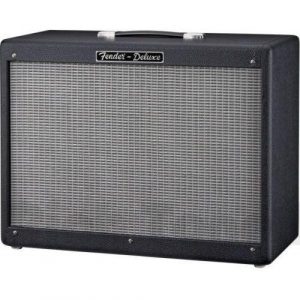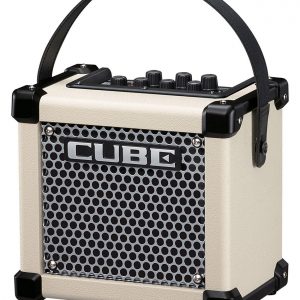Marshall DSL5C
$277.99
The Marshall DSL5C guitar amp combines classic valve tones with modern features for the ultimate home and studio practice amp.
Compare
Description
If you’re one of those guitar players who are on the lookout for great tone, then the Marshall DSL5C guitar amp is the perfect choice for you! This versatile amp is designed to deliver a fantastic tonal range, making it suitable for all genres of music, from blues to rock, metal, and beyond.
The DSL5C is a compact and lightweight, but powerful amp that provides 5 watts of pure tube power. With two channels, clean and lead, you can shape and define your sound to your liking. The clean channel delivers a crisp and clear tone that is perfect for chord progressions and arpeggios. The lead channel provides an overdriven tone that provides plenty of distortion and sustain, perfect for soloing or heavy riffs.
Like all Marshall amps, the DSL5C is built to last, with its sturdy construction and high-quality components. The amp comes equipped with a 10-inch Celestion Ten-30 speaker, which is designed to enhance the Marshall tone and provide an outstanding sonic experience. The speaker delivers a powerful sound with plenty of clarity and definition, perfect for both practicing and performing.
Another great feature of the DSL5C is its tone-shaping options. With the amp’s three-band EQ, you can tailor your sound to your preferences, making it easy to shape your tone to your individual playing style. Additionally, the amp features a reverb effect that adds a beautiful, atmospheric touch to your sound.
Overall, the Marshall DSL5C guitar amp is an exceptional piece of equipment that every guitar player should consider. With its compact size, outstanding tone, and high-quality components, it’s a fantastic addition to any setup, no matter the genre of music you play. Whether you’re a beginner, intermediate or advanced player, the DSL5C is an amplifier that won’t disappoint.
Marshall DSL5C properties
| Product name |
DSL5C |
| Brand |
Marshall |
| Type |
Guitar Amplifiers |
| Amplifier Model |
Hybrid Combo |
Frequently Asked Questions:
What are the unique features and benefits of the Marshall DSL5C combo amplifier, and how does it compare to other models in the DSL series?
The Marshall DSL5C combo amplifier is a versatile and powerful guitar amplifier that offers a range of unique features and benefits. Here are some of its key attributes:
1. RMS power output: The DSL5C delivers plenty of clean headroom, making it suitable for both live performances and studio recordings. It's also versatile enough to handle high-gain distortion without breaking up or sounding muddy. Two independent channels: Each channel has its own volume, gain, EQ, and effects controls, allowing you to create two distinct sounds simultaneously. This makes the DSL5C ideal for guitarists who play in multiple styles or use different instruments. Digital reverb and delay effects: The DSL5C comes loaded with high-quality digital reverb and delay effects, which can be adjusted via the front panel controls. These effects add depth and dimension to your tone, helping you create richer and more complex sounds. Celestion Vintage 30 speakers: The DSL5C features a pair of Celestion Vintage 30 speakers, which are known for their clarity, warmth, and dynamic range. These speakers allow the amplifier to deliver a wide variety of tones, from bright and crisp clean sounds to thick and punchy overdrive. Patented ISF control: The DSL5C features Marshall's patented ISF (Integrated Subtle FX) control, which allows you to fine-tune the amp's tonal response to suit your playing style and preferences. This feature gives you access to a wide range of sounds, from traditional British crunch to modern American high-gain. Compared to other models in the DSL series, the Marshall DSL5C stands out for its versatility and flexibility. Its two independent channels and digital effects make it ideal for guitarists who play multiple styles or use different instruments. Additionally, the Celestion Vintage 30 speakers and ISF control provide a level of tonal range and customization that is unmatched by other amplifiers in this price range. Overall, the Marshall DSL5C combo amplifier is an exceptional choice for guitarists who demand versatility, power, and tone. Its unique features and benefits make it a standout in the crowded world of guitar amps, and it's sure to please players of all levels and styles.
What unique features set the Marshall DSL5C apart from other combo amplifiers, and how does it deliver exceptional sound quality for both practice and small-scale performances?
The Marshall DSL5C combo amplifier stands out from its competitors due to its unique Celestion Vintage 30 speakers and the patented Marshall "clean" channel. These features provide exceptional sound quality that is both clear and dynamic, making it ideal for both practice and small-scale performances. The Celestion Vintage 30 speakers offer a warm, rich tone that is perfect for blues, rock, and classic rock genres. The speakers deliver a balanced frequency response with plenty of low-end rumble and crisp highs. This ensures that the sound produced by this amplifier is full-bodied and resonant, providing an immersive listening experience. The patented Marshall "clean" channel is another unique feature that sets the DSL5C apart from other combo amplifiers. This channel offers a pristine, unadulterated sound that is perfect for playing clean or lightly overdriven guitar parts. The clean channel also allows for plenty of headroom, which means it can handle loud input signals without distorting or clipping the sound. The Marshall DSL5C delivers exceptional sound quality for both practice and small-scale performances due to its versatility and flexibility in terms of tone and volume control. The amplifier offers a variety of tonal options, including clean, classic gain, and ultra gain channels, as well as master volume, resonance, and presence controls. This allows the player to dial in the exact sound they need for their specific playing situation. In summary, the unique features of the Celestion Vintage 30 speakers and patented Marshall "clean" channel make the DSL5C an exceptional choice for guitarists looking for both practice amp and small-scale performance capabilities. Its versatility, clarity, and rich tone ensure that it will deliver exceptional sound quality in a variety of settings, making it a must-have addition to any musician's arsenal.
What is the specific difference between the DSL5C's two-channel design and its predecessor, the DSL100HR?
Channel A, which is designed for clean tones, and Channel B, which is optimized for overdriven or distorted sounds. In contrast, the DSL100HR has a single channel with three separate gain settings: 1, 2, and 3. These settings allow players to adjust the amount of gain applied to the signal, but they don't offer the same level of tonal distinction as the two channels on the DSL5C. One key difference between the two channels on the DSL5C is the tone shaping capabilities. Channel A features a low-gain, clean circuit with a more neutral EQ response, making it ideal for players who want to maintain their guitar's natural tone while still having access to some overdrive. On the other hand, Channel B has a high-gain, overdriven circuit with a more scooped midrange and a higher presence boost, which is better suited for players who want a bold, aggressive sound. Another difference between the two channels is the way they interact with the DSL5C's reverb and delay settings. Players can use Channel A to create a clean, dry sound and then add some ambiance using the reverb or delay effects, while Channel B allows for more aggressive tone shaping, making it easier to craft unique sounds that blend overdrive and atmospheric effects. The two channels on the DSL5C also provide independent EQ controls, allowing players to tailor their tone even further. The high-gain channel has a built-in mid-scoop, which is designed to cut through mixtures while maintaining clarity, and the low-gain channel features a more neutral EQ response with a wider frequency range. In summary, the main difference between the DSL5C's two-channel design and its predecessor, the DSL100HR, lies in the level of tonal distinction offered by each channel. The DSL5C provides two distinct channels, each with its own set of tone shaping capabilities, while the DSL100HR has a single channel with various gain settings that don't offer the same level of flexibility. That being said, both amplifiers are designed to deliver high-quality sound and are suitable for players who want a wide range of tonal options. However, if you're looking for an amplifier with more versatility and advanced tone shaping capabilities, the DSL5C's two-channel design may be a better fit for your needs.
What is the optimal setting for the mid-frequency control on a Marshall DSL5C to achieve a balanced tone between the low-end warmth and high-end clarity?
1. Determine your guitar's tonal characteristics**: Before tweaking the mid-frequency control, consider the natural tone of your guitar. If it has a strong bass response (e. Les Paul), you may want to emphasize the upper mids to cut through the mix. Conversely, if your guitar tends to sound thin or lacking in low-end punch (e. Stratocaster), you might want to add warmth by reducing the mid-frequency boost. Set the bass control**: To achieve a balanced tone, ensure that the bass response is neither too boomy nor too weak. Aim for a moderate setting (around 4-5) on the bass control, depending on your guitar and playing style. Adjust the mid-frequency control**: With the bass under control, now focus on the mid-frequency control. A good starting point is to set it around the middle of its range (usually around 50-60% of maximum). This will provide a relatively flat response with some warmth in the lower mids and clarity in the upper mids. Add low-end warmth or high-end clarity as needed**: If your tone sounds too harsh or lacking in warmth, try reducing the mid-frequency control to emphasize the lower mids (around 40-50%). Conversely, if your tone sounds muddy or lacking in clarity, increase the mid-frequency control to boost the upper mids (around 60-70%). Tweak the treble control**: Finally, adjust the treble control to balance out any harshness or sibilance. A good starting point is to set it around the middle of its range (usually around 50-60%). Some general guidelines for different playing styles and tone preferences:
* For a warm, vintage tone: Set the mid-frequency control around 40-50% and reduce the treble control. For a clear, articulate tone: Set the mid-frequency control around 70-80% and increase the treble control. For a balanced, all-around tone: Set the mid-frequency control around 50-60% and adjust the bass and treble controls accordingly. Remember that these are general guidelines, and the optimal setting will ultimately depend on your specific guitar, playing style, and personal tone preferences.
Before you buy Marshall DSL5C










Uzial –
A clean channel is a plus when someone knows how to play with bass and soprano, but when it comes to distortion channel: the less the better. It works fine on a light crunch, but I personally don’t recommend using this channel at all. It’s just a fart with sand instead of sound. The amplifier is light, small, and considering its dimensions and the fact that it is a transistor, it can be quite loud when needed.
I recommend it for practicing at home or when starting your adventure with the guitar.